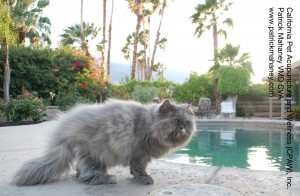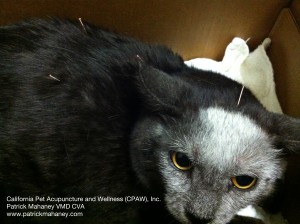 My clinical practice in veterinary acupuncture primarily caters to dogs, but feline patients, especially those with immune system compromising conditions (cancer, chronic infection, etc) have been increasingly coming my way for treatment. The inquisitive clients attached to my cat patients always have a variety of questions for which I strive to give the most helpful answer based on my experience. Having previously only lived with cats in for a short time, I sometimes seek guidance regarding everyday feline care taking.
Darlene Arden’s The Complete Cat’s Meow (Howell Book House) provides a wealth of information helpful to cat fanciers. I found myself connecting with the practicality of Arden’s advice and will utilize some of her suggestions when consulting with my clients.
Arden’s book thoroughly covers basic kitten and cat health care, feline infectious and non-infectious diseases, appropriate and inappropriate behavior patterns (including appetite, bowel movement, urination, etc), environment and lifestyle suggestions, and breed characteristics.
My clinical practice in veterinary acupuncture primarily caters to dogs, but feline patients, especially those with immune system compromising conditions (cancer, chronic infection, etc) have been increasingly coming my way for treatment. The inquisitive clients attached to my cat patients always have a variety of questions for which I strive to give the most helpful answer based on my experience. Having previously only lived with cats in for a short time, I sometimes seek guidance regarding everyday feline care taking.
Darlene Arden’s The Complete Cat’s Meow (Howell Book House) provides a wealth of information helpful to cat fanciers. I found myself connecting with the practicality of Arden’s advice and will utilize some of her suggestions when consulting with my clients.
Arden’s book thoroughly covers basic kitten and cat health care, feline infectious and non-infectious diseases, appropriate and inappropriate behavior patterns (including appetite, bowel movement, urination, etc), environment and lifestyle suggestions, and breed characteristics.
 Some of my favorite aspects of The Complete Cat’s Meow and pet care topics I feel are most helpful to my cat care taking clients include:
Moggie
Until reading Arden’s book I was not familiar with the term moggie, which refers to a cat of mixed breed lineage. Most of my feline patients are considered domestic short hairs, so I now have a term to appropriately apply to these mongrel cats.
Safety Proofing Your Home Environment
Cats are curious and will explore their environment with sense, smell, and taste organs. Arden indicates some common household toxicities and hazards of the home, such as aerosol sprays, liquid potpourri, scented oils, seasonal plants, office accessories (tacks, paperclips, etc), and even paper shredders.
Cat Carriers
It pains me to see clients transport their cat out of the relative safety of their home environment without using an appropriate carrier (See Beverly Hills 90210 AnnaLynne McCord, Please Use a Carrier to Transport Your Cat on Celebrity Pet News). Arden feels similarly and stresses that even the calmest cat can be frightened and potentially escape (or scratch up AnnaLynne’s pretty face), especially in emergency situations. So, always have handy and use a comfortable, sturdy carrier for out of home excursions.
Feline Lower Urinary Tract Disease (FLUTD)
This common, potentially costly and life threatening disease strains the relationship between cat and caretaker. Arden stresses how FLUTD is multifactorial and may have origins in our cat’s food (commercially available dry), lack of moisture (definitely purchase a recirculating water fountain), pain (arthritis causes discomfort while posturing to void), environmental factors (stress negatively affects immune health), and behavior issues (crowded and waste filled litter boxes motivate cats to seek alternative locations to eliminate, so scoop daily and have multiple boxes available).
Clinical Signs of Feline Illness
Since cats instinctually hide their sickness to avoid being preyed upon, their outward manifestation of disease may be subtle and elude our observation. Arden’s helpful list of signs illness as suggested by the Feline Veterinary Medical Association (FelineVMA) promotes keen awareness of your cat’s day to day habits so that medical evaluation and treatment can be hastily sought.
Pain Management and Physical Rehabilitation
I greatly appreciate Arden informing readers of the clinical signs felines show when they are in pain and the use of medications (minimal use of anti-inflammatory drugs), supplements (chondroprotectants, omega fatty acids, etc), lifestyle (weight loss) and environment changes (easy litter box access), and physical rehabilitation (including massage and range of motion work) as means of managing discomfort. Cat owners should not rely on a single means of pain management, such a giving medication, and taking a multimodal approach can promote your cat’s longer term positive outcome.
Some of my favorite aspects of The Complete Cat’s Meow and pet care topics I feel are most helpful to my cat care taking clients include:
Moggie
Until reading Arden’s book I was not familiar with the term moggie, which refers to a cat of mixed breed lineage. Most of my feline patients are considered domestic short hairs, so I now have a term to appropriately apply to these mongrel cats.
Safety Proofing Your Home Environment
Cats are curious and will explore their environment with sense, smell, and taste organs. Arden indicates some common household toxicities and hazards of the home, such as aerosol sprays, liquid potpourri, scented oils, seasonal plants, office accessories (tacks, paperclips, etc), and even paper shredders.
Cat Carriers
It pains me to see clients transport their cat out of the relative safety of their home environment without using an appropriate carrier (See Beverly Hills 90210 AnnaLynne McCord, Please Use a Carrier to Transport Your Cat on Celebrity Pet News). Arden feels similarly and stresses that even the calmest cat can be frightened and potentially escape (or scratch up AnnaLynne’s pretty face), especially in emergency situations. So, always have handy and use a comfortable, sturdy carrier for out of home excursions.
Feline Lower Urinary Tract Disease (FLUTD)
This common, potentially costly and life threatening disease strains the relationship between cat and caretaker. Arden stresses how FLUTD is multifactorial and may have origins in our cat’s food (commercially available dry), lack of moisture (definitely purchase a recirculating water fountain), pain (arthritis causes discomfort while posturing to void), environmental factors (stress negatively affects immune health), and behavior issues (crowded and waste filled litter boxes motivate cats to seek alternative locations to eliminate, so scoop daily and have multiple boxes available).
Clinical Signs of Feline Illness
Since cats instinctually hide their sickness to avoid being preyed upon, their outward manifestation of disease may be subtle and elude our observation. Arden’s helpful list of signs illness as suggested by the Feline Veterinary Medical Association (FelineVMA) promotes keen awareness of your cat’s day to day habits so that medical evaluation and treatment can be hastily sought.
Pain Management and Physical Rehabilitation
I greatly appreciate Arden informing readers of the clinical signs felines show when they are in pain and the use of medications (minimal use of anti-inflammatory drugs), supplements (chondroprotectants, omega fatty acids, etc), lifestyle (weight loss) and environment changes (easy litter box access), and physical rehabilitation (including massage and range of motion work) as means of managing discomfort. Cat owners should not rely on a single means of pain management, such a giving medication, and taking a multimodal approach can promote your cat’s longer term positive outcome.
 Appendix of Resources
Arden concludes the book with a helpful collection of useful organizations and websites aimed at promoting feline health and educating cat owners. I frequently refer to (and suggest my clients do the same) these resources and have found them helpful in the medical management of my feline patient’s issues.
Now that I have completed The Complete Cat’s Meow, I’m motivated to read Arden’s take on canines from her book Small Dogs, Big Hearts.
Please see my other book reviews on Patrick’s Blog:
Could Enzo From The Art of Racing in The Rain Have Lived More Comfortably As A Senior Dog
Dr. Mahaney’s Book Review- I (Heart) My Dog
Please feel free to leave your comments or communicate with me through email (patrick@patrickmahaney.com) or Twitter (@PatrickMahaney).
Thank you for reading my article. To receive my next veterinary posting via email, please press the “Don’t Miss a Blog Post” button on the right upper corner of this page or follow this link.
Make sure to follow my adventures in veterinary medicine by friending Patrick Mahaney: Veterinarian Acupuncture Pain Management for Your Pets on Facebook.
Copyright of this article (2011) is owned by Dr. Patrick Mahaney, Veterinarian and Certified Veterinary Acupuncturist. Republishing any portion of this article must first be authorized by Dr. Patrick Mahaney. Requests for republishing must be approved by Dr. Patrick Mahaney and received in written format.
Appendix of Resources
Arden concludes the book with a helpful collection of useful organizations and websites aimed at promoting feline health and educating cat owners. I frequently refer to (and suggest my clients do the same) these resources and have found them helpful in the medical management of my feline patient’s issues.
Now that I have completed The Complete Cat’s Meow, I’m motivated to read Arden’s take on canines from her book Small Dogs, Big Hearts.
Please see my other book reviews on Patrick’s Blog:
Could Enzo From The Art of Racing in The Rain Have Lived More Comfortably As A Senior Dog
Dr. Mahaney’s Book Review- I (Heart) My Dog
Please feel free to leave your comments or communicate with me through email (patrick@patrickmahaney.com) or Twitter (@PatrickMahaney).
Thank you for reading my article. To receive my next veterinary posting via email, please press the “Don’t Miss a Blog Post” button on the right upper corner of this page or follow this link.
Make sure to follow my adventures in veterinary medicine by friending Patrick Mahaney: Veterinarian Acupuncture Pain Management for Your Pets on Facebook.
Copyright of this article (2011) is owned by Dr. Patrick Mahaney, Veterinarian and Certified Veterinary Acupuncturist. Republishing any portion of this article must first be authorized by Dr. Patrick Mahaney. Requests for republishing must be approved by Dr. Patrick Mahaney and received in written format.